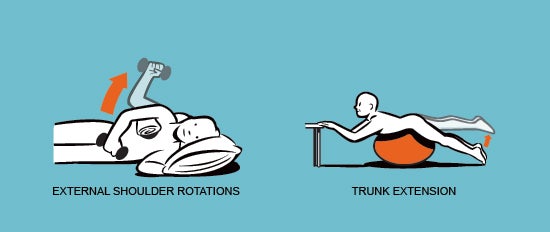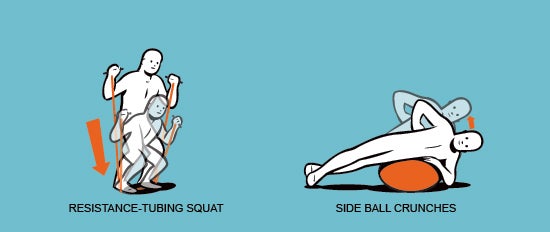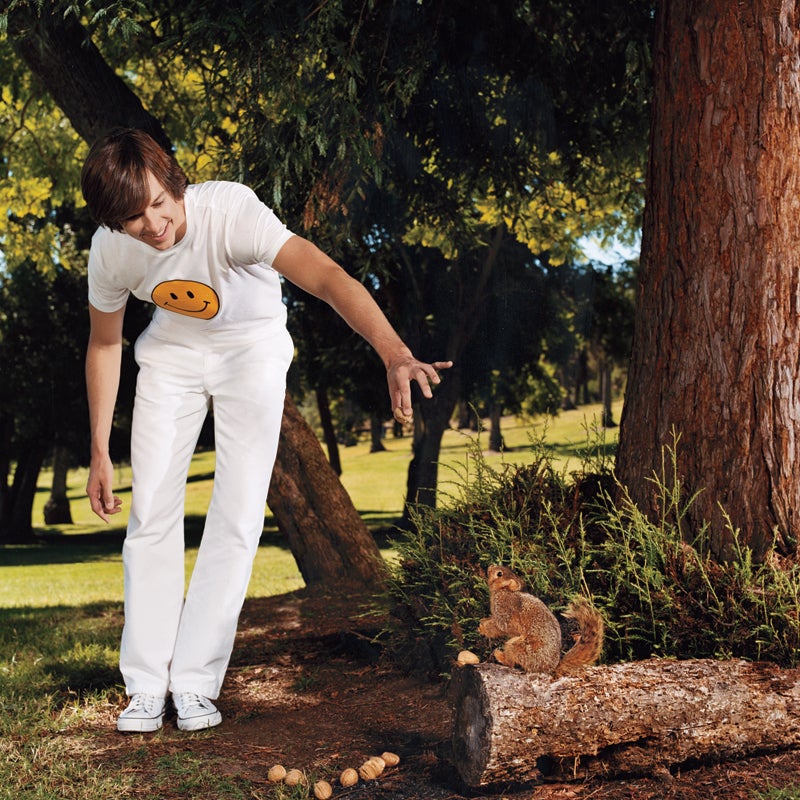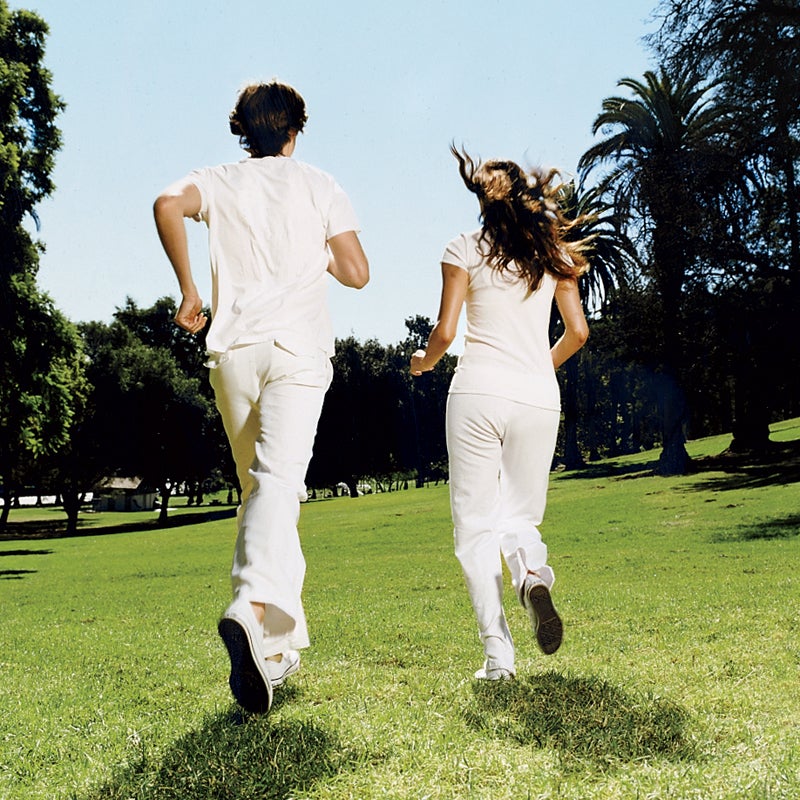Now's the time to dial in your perfect world, one with stronger fitness, less stress, more fun, better health, and all the adventure you can handle. Sound too good to be true? Let endurance king Dean Karnazes and our five-part action plan guide you to greatness—then get ready for your best year ever.
Step 1: Get Fit, Eat Right
A Life Cheat Sheet from Dean Karnazes
You're entitled to call Dean Karnazes crazy. After all, the 44-year-old ultrarunner from San Francisco has some iffy tics, like jogging 350 miles in one shot and, most recently, knocking off 50 marathons in 50 states in 50 days (and then announcing, on November 6, that he'll run home—from New York City). But hang out with the endurance dynamo and you realize he's not nuts; he's just happy. What's his formula for fulfillment?
Katie Arnold caught up with Karnazes for race number 22, and this as-told-to interview, in Albuquerque, New Mexico. She discovered—when three miles became 13 and next thing she knew she'd run her first marathon, without training—that Karnazes's energy can rub off on the rest of us. Presenting five nuggets of wisdom from Ultramarathon Man himself:
Do What You Love
I never really had a five-year plan. I just asked myself, “If I could script my perfect life, what would it look like?” It would be spending a lot of time with my family and my kids; doing what I love, which is exploring the limits of human endurance; being in the shape of my life; and dedicating myself wholeheartedly to my craft. I love nothing more than to run through the mountains for 100 miles. It's been the most rewarding experience of my life.
It's Never Too Late
I ran a lot as a kid but quit in high school. I didn't run again until my 30th birthday, when I realized that I wasn't fulfilled and had to make a change. I walked right out of the bar and ran 30 miles through the night. That was 14 years ago, and the longest I've gone without running since is two or three days. For most of that time, I worked in the marketing department of a pharmaceutical company; in 2003, I cofounded an organic-snack-food company.
“On a normal day, I get up at 4 in the morning and run 20 to 25 miles before breakfast. Then I go windsurf or bike.”
Balance is BS
On a normal day, I get up at four in the morning and run 20 to 25 miles before making breakfast and taking the kids to school. My average night's sleep is about four hours. Learning to sleep so little took me about a month. It was really, really tough. I used to set my alarm and force myself to wake up. But what I've found now is that those four hours of sleep are restorative, whereas the seven or eight I used to get was a lot of restless stirring around. I also started tuning in to my diet. I cut out most processed foods and refined sugars. It took me a month to wean myself from sugar. But once you get over the hump, you've got this constant high level of energy. And when you feel good, you're much more motivated. I cross-train three or four days a week, on top of running. I might go windsurfing or mountain-biking before picking up the kids. That's my life. It's frenetic, it's crazy, it's fast-paced. There's no balance.
Get Uncomfortable
I think Western culture has things backwards. We equate comfort with happiness, and now we're so comfortable we're miserable. There's no struggle in our life, no sense of adventure. I've found that I'm never more alive than when I'm pushing and I'm in pain and I'm struggling for high achievement. In that struggle, I think there's a magic.
Unless you're pushing yourself, you're not living to the fullest. You can't be afraid to fail, but unless you fail, you haven't pushed hard enough. If you look at successful people and happy people, they fail a lot, because they're constantly trying to go further and expand.
That's what ultrarunning can teach you: Nothing comes easy. Running 100 miles is a huge commitment. There's no way to fake your way through that kind of distance. If you take shortcuts, you pay the price. When you're out at mile 80 and you're ready to give up, you're thinking, Man, I compromised on my training. I should have done those extra ten miles. And I know I didn't. Or you're saying, I paid my dues, I laid out my training, I didn't compromise, I ran those extra ten miles: I know I can pull this off.
Be Your Biggest Cheerleader
As with anything, you have to believe that you can do it. And I think that's a learned trait. If someone had said to me before I started running ultras, “You're going to go out and run 100 miles through the mountains,” I would have said no human being can do that, let alone me. And then when you actually achieve that, it teaches you that you're better than you think you are and that you can do more than you think you can. All along, that's what I hoped the Endurance 50 would do—inspire others to push themselves and do their best. I believe that anyone can do exactly what I'm doing.
Eat Mindfully—Here's How
Step one to creating a food formula that powers you to new performance peaks is to keep a journal recording how you react to what you eat. Lynn Smith, owner of Boulder, Colorado-based Source Nutrition and an adviser to dozens of the town's elite endurance runners, says the key to really learning what you need is to go beyond simple observations of food types, quantity, and calorie intake and take stock of four fundamental indicators: mood, mental clarity, energy, and digestion.
Smith doesn't give rules about frequency or format of entries but says a regular routine is key, as it will allow you to recognize the often simple patterns that can hold you back. Of course, identifying a problem—”Huh, I always bonk when I have granola for breakfast”—doesn't give you an immediate remedy, but keep tinkering with your diet and paying attention and you'll soon become an expert on yourself. Meanwhile, here are a few common symptoms, along with Smith's suggestions for potential fixes.
- Bloated Belly: You could be downing too many sugars or other refined carbohydrates, which your body stores by retaining water.
- Losing focus before lunch: Add some oomph to your breakfast with more protein in the form of eggs, peanut butter, cheese, yogurt, or last night's leftover meat dish.
- The 4 p.m. Meltdown: Scarf a small, nutrient-dense snack, like a handful of walnuts and sunflower seeds.
- Hating your post-work workout: Make sure you ate properly yesterday; inadequate meals often won't affect your performance until 24 hours later.
Prevent Injury with These 4 Moves
Nothing halts your journey to athletic greatness faster than an injury. The trick to avoiding them? Don't fall. But if you do, your odds of walking rather than hobbling away will be much better if you've built up essential support and stability muscles. Bryan Diekmann, who sees some 50 new injuries a week during the winter as a trainer at Vail, Colorado's Steadman Hawkins Clinic, one of the nation's top sports-medicine centers, offers four exercises* to strengthen your defenses.

External Shoulder Rotations
Prevents dislocations, sprains, and tears by working the oft-ignored muscles behind your shoulder, which provide socket support during a wipeout. Lying on your side, with your top elbow locked at 90 degrees against your hip and a rolled towel in your armpit, rotate a small dumbbell (under 20 lbs) away from your body.
Trunk Extension
Helps avoid lower-back strains and sprains by building those muscles so you can withstand the sudden lurches of impact sports. Holding on to a weight bench and resting facedown on a Swiss ball placed under your hips, raise both legs so that your body is completely straight, then lower (20 reps).

Resistance-Tubing Squat
Boosts overall lower-body endurance to avoid those last-run-of-the-day-type injuries by developing all essential leg muscles in coordination to put some power in your balancing skills. Start with your legs bent roughly 30 degrees, standing on a taut resistance tube held at shoulder height; squat to 70 degrees (25—50 reps).
Side Ball Crunches
Helps you stay physically centered so you don't biff in the first place by building obliques, which run alongside your torso. Lying sideways with a Swiss ball under your right hip and your feet crossed where floor meets wall, raise your torso toward the ceiling (20 reps each side).
*For all exercises, do 3 to 6 sets, building at your own pace.
Ditch Your Desk
Among the many annoyances of having a desk job—Mondays, office “parties,” having to change out of your pajamas—the worst can be the impact on your training. Grinding out ten-hour days in front of a computer has a seriously degrading effect on all things physical.
Enter James Levine, a Mayo Clinic endocrinologist who recently devised a fully functional desk built around a treadmill to bring activity to the office slave's routine. Levine and other Mayo researchers tested the desks themselves, walking one mile per hour while e-mailing, crunching data, and taking calls (including one for this story).
The result: They burned roughly 100 extra calories an hour. That's a significant number for competitive racers looking to shave some pounds in order to boost finish times—or tie on a workout buzz before filling out another TPS report. Levine is now collaborating with five U.S.-based companies to bring his design to their offices. But for those looking to gain that extra edge right away, do as Dean Karnazes does and add some easy energizing action to your workday habits.
- Use a wireless headset so you can pace your office during those interminable conference calls.
- Work at a stand-up desk.
- Have walking meetings instead of gathering around a table.
- Skip that third cup of coffee and instead bust out a set of push-ups or crunches.
Step 2: Go Already
Acting on your wanderlust will work wonders.
“I don't have time” is the most overused excuse in the book. “Too many people sit passively, waiting to get enough time off to travel,” says Rolf Potts, author of Vagabonding: An Uncommon Guide to the Art of Long-Term World Travel. “But it will never happen, because the American corporate world isn't set up to reward you with free time.” Potts's strategies (below) will help you create your own. (For added inspiration, visit Vacation Campaign)
- Take all of your vacation time: Studies consistently show that Americans rarely take all of their allotted time off even if it's a measly two weeks. It's yours. You've earned it. What are you waiting for?
- Negotiate a sabbatical: “These can be paid or unpaid, depending on the situation. The bottom line is, an unpaid leave of absence is better than none at all.”
- Fine-tune your career to create more natural pauses: “Many people are getting more creative at doing seasonal or contract work, which frees you up to travel.”
- If all else fails, quit: (But first devise a solid six-month financial backup plan.) “Make strategic use of a time-honored personal-freedom technique popularly known as 'quitting,' ” says Potts. “It doesn't have to be reckless.” Second opinion? Travel writer Pico Iyer refers to quitting as “a step in a better direction.”
Spread the Love
If you feel too guilty to take off for no good reason, try combining it with an altruistic mission or a self-improvement goal. The opportunities are endless, from developing a portable library system in Vietnam to assisting at a school for the deaf in Brazil. And there's nothing wrong with a self-help mission to perfect your surfing in Mexico or partake in Ironman New Zealand, either. Keep in mind, however, that altruism doesn't always equal inexpensive: A volunteer trip to Brazil might run $2,500 for two weeks, not including airfare. And take this tip from Doug Cutchins, co-author of Volunteer Vacations: Check out the U.S. State Department for travel warnings before you sign on. A few good sites: Cross-Cultural Solutions (crossculturalsolutions.org), Globe Aware, Global Volunteers.
Commit to a Yearly Vacation
Whether you're climbing Rainier with college buddies or joining an outfitted kayaking trip in Uruguay, scheduling an annual expedition is money in your sanity bank. No one knows how to do it better than Outside reconnaissance agent Mark Jenkins. His advice on how to make it happen:
- Find the right partner: “Everybody will say, 'Great, amazing, I want to go'; 90 percent won't. Line up a number of potential partners and hope that one will come through. If they don't, go anyway.”
- Go where you want to go, period: “If this is your big escape, don't be cheap. Do what you want.” Just be prepared to skimp on post-trip lattes.
- Go long: “Two weeks is the minimum. Any less and your head will never really disconnect from the office.”
- Psych up your body and mind: “You will hate yourself if you're out of shape. Besides, training for a big trip is a way to get psyched.” Ready your mind by studying up on the destination read books, watch films, and peruse local Web sites.
Rent Globally
Renting a home away from home has become increasingly easy, thanks to online resources like Rentalo.com, VRBO.com, HomeAway.com, and Airbnb.com. In addition to saving you money, house renting or swapping can plant you in otherwise remote parts of the world. Start by deciding what type of vacation you want, then do the following homework suggested by Susan Stellin, author of How to Travel Practically Anywhere (Houghton Mifflin).
- Play the field: If looking to rent overseas, go through an agency unless you speak the language and know the area, advises Stellin. “You'll have the added security that somebody is standing behind the rental in case the electricity goes out.”
- Seek out word of mouth: For an unbiased review, ask someone who's been there, done that. If you don't know anyone who's rented a house in Croatia, toss out a question on a travel forum (thorntree.lonelyplanet.com) to find an agency.
- Get curious: Pepper your source with questions: What am I not seeing in these photos? Who can I call if I need help? “The more questions you ask, the better,” says Stellin. “If you aren't getting the answers you want, it's a good reason to move on.”
Step 3: Simplify
Scale back to go big: Lessons learned from Thoreau.

Given the swarm of swamis, shrinks, and life coaches these days, it can be hard to differentiate between the genuinely helpful and those aiming to enrich only their bottom line. Which is why we like to go back to Transcendentalist guru Henry David Thoreau, whose bible of minimalism, Walden, exhorted his countrymen to “simplify, simplify.” Granted, that was back in 1854, when Thoreau's primary distraction was the mail (“I could easily do without the post office”), but many of his prescriptions for a streamlined life still apply. Take heed, and transcend.
Thoreau says: “Let your affairs be as two or three, and not a hundred or a thousand.”
Thoreau was obsessed with preserving a “broad margin of leisure” in his schedule, so he cut his to-do list down to the essentials: thinking, writing, hoeing his bean rows, and evading human contact. Your interests may differ, but the strategy works: Weed out the extraneous—like those nagging social obligations you never have the guts to decline—so you have more time to surf, ski, bike, and play.
Thoreau says: “Do what you love. Know your own bone; gnaw at it, bury it, unearth it, and gnaw it still.”
Damn straight! (Unless what you love is sitting on the couch eating Doritos and playing Xbox.) Jump-start your stalled passions by enrolling in a course or a workshop; you'll be amazed how a weekend of refining your fly-fishing skills or honing your photographic eye can reignite long-dormant recesses of your brain.
Thoreau says: “If a man does not keep pace with his companions, perhaps it is because he hears a different drummer.”
More often than not, greatness is achieved by those who follow their own muse. This doesn't necessarily mean ditching your day job and becoming a river guide, but it does mean having more faith in your own creativity. So if there's an idea you've been sitting on because it goes against conventional wisdom—like taking a leave to sail to Mexico or pitching a plan for community bike lanes to city hall—now is the time to act on it.
Thoreau says: “I never found the companion that was so companionable as solitude.”
Though you'll probably want to stop short of Thoreau's hermetic extreme, spending some quality time alone helps bring mental clarity and perspective: Try to block out a minimum of 30 minutes a day of solo time—be it on your mountain bike or your meditation mat.
Thoreau says: “Superfluous wealth can buy superfluities only.”
We're not going to tell you to give up certain nonessentials, like your new powder skis or this magazine, but the core thinking behind Thoreau's willful poverty is worth practicing. Make a habit of giving away or purging five things a week. Start with that old pair of sunglasses from your junk drawer, ancient receipts you no longer need, or that kelly-green CB ski jacket that's been hanging in your gear closet since 1988.
Help Yourself
Today's experts pick up where Thoreau left off, advocating easy first steps to simplifying your life.
Aim High
“A great life is not the result of a few gigantic wins,” says Robin Sharma, who's coached high-profile corporate clients like Nike and Microsoft through his company, Sharma Leadership International Inc. “It's the result of the small, consistent, 1 percent wins.” Here's Sharma's advice for getting started:
- Expose Your Excuses: Keep a notebook with you and make a top-ten list of your most common cop-outs (“No first ascent—I have to mow the lawn”) so you can start eliminating them.
- Clean up your messes: Start with the clutter on your desk and work up to financial, personal, or any other unfinished business hanging over your head. This will free you up for more creative pursuits.
Make Time to Play
How to reprioritize when all you do is work? Schedule some quality goofing-off time with family or friends at least once a week: Shoot hoops, play guitar, ambush someone with a water balloon. “Life is like a good meal—you need to have a little bit of everything,” says Deborah Szekely, 84, founder of Baja-based Rancho La Puerta, North America's original fitness resort and spa. “And you certainly need dessert.”
Embrace Imperfection
When in doubt, adopt the Japanese worldview of wabi sabi, which celebrates the beauty of all things imperfect, impermanent, and incomplete. (That includes you.) “Wabi sabi is not a license to become complacent,” instructs Taro Gold, author of Living Wabi Sabi: The True Beauty of Your Life. It's about using your missteps to “look at the map you drew for yourself and reevaluate where you stand.” Even Thoreau would approve of this. “It is not worth the while to let our imperfections disturb us always,” he wrote in A Week on the Concord and Merrimack Rivers. Just some of the time.
Step 4: Give Back
Because a little bit of effort can make a world of difference.

Bad news for selfish bastards: A new wave of studies shows that altruistic people not only live longer; they also lead healthier, less stressful lives. “Researchers have all but proven that people actively engaged in supportive behavior reap their own rewards in mental and physical health,” says Stephen Post, a professor of bioethics at Cleveland's Case Western Reserve University and co-author (with Jill Neimark) of Why Good Things Happen to Good People, out in May from Random House.
Biologists have long known that when we help others—whether by distributing outdoorwear to disaster victims or taking disabled athletes out on the ski slopes—our brains release the same endorphins responsible for a runner's high, inducing feelings of well-being, reducing stress, and even strengthening the immune system. Now, dozens of studies funded by the—ahem—Institute for Research on Unlimited Love, a nonprofit Post set up in 2001 to study benevolence, are turning up longer-term benefits. Scientists who observed volunteers over the course of decades concluded that anxiety and depression dropped significantly for those who gave help, even more than for those who received it. Elsewhere, altruistic people were shown to have more success in relationships. And people who volunteered were up to 63 percent more likely to live a longer life. “I'd argue with Billy Joel when he sings about the good dying young,” Post says. “What we're finding is that actually the good tend to do a little better.”
The key, it seems, is personal involvement. “I would never take anything away from someone who writes a check,” says Post, “but there's no doubt that direct helpfulness, as long as it doesn't overwhelm the giver, has tremendous health benefits.” So do it for your heart and your ticker.
Lend a Little
Microfinancing—making small, interest-free business loans to impoverished people in developing countries—is all the buzz. See firsthand what a difference it can make by investing as little as $25 at kiva.org, a San Francisco—based site that works with microcredit groups around the world to help entrepreneurs like Agnes Meseno Silei, who's seeking a grand total of $300 to start a beadwork business in Kenya. You'll choose your loan recipient (Kiva features photos and bios) and receive regular e-mail updates about his or her progress. And you'll likely get your money back within two years—loans are not guaranteed, but Kiva has a 100 percent repayment rate—just in time to reinvest and help someone else find economic independence.
Share Your Sport
Juan Herrera is a 23-year-old kid from the salty-aired but sometimes mean streets of San Diego. Adopted as a child in Tijuana, moved from family to family, and homeless by high school, he was on a trajectory toward gangs, drugs, and no way out—until one day the way out came, in the form of a nonprofit called Outdoor Outreach. Founded by former competitive skier Chris Rutgers to get challenged teens out of the rehab center and into the wilderness, the program transformed Herrera, whose sporting life to that point consisted of kicking around his neighborhood on a BMX bike, into a maestro on the singletrack, in the halfpipe, and on the Southern California granite.
Today Herrera is an Outdoor Outreach staff member who spends every weekend with about a dozen kids, ages 12 to 18, going surfing or mountain-biking in San Diego County, snowboarding at Mammoth, and scaling cliffs in Mission Gorge. “At first it's really common for them to be scared,” he says, “but once they see their friends having fun, I guarantee by the end of the day all of them are climbing.
“For these kids, life is about day-to-day survival,” he adds, “so for me to give them the opportunity that was given to me—that's what's important. I could've ended up a junkie; now I'm an adrenaline junkie.” He's also an “Outdoor Idol,” according to the Outdoor Industry Foundation, which this year honored Herrera and seven others—including kayaker Rush Sturges, 21, and 20-year-old climber Emily Harrington—for both excelling in their sports and inspiring the next generation to do the same.
The idea that getting outside can have mental as well as physical benefits has been gathering momentum since the 1960s, when Outward Bound and NOLS introduced young people to the backcountry and watched them morph into more confident versions of themselves. These days, athletes from world-class competitors to weekend enthusiasts are following suit: Golden, Colorado's Big City Mountaineers, founded by the American Hiking Society's Jim Kern, takes kids backpacking and canoeing; First Descents, established in 2001 by pro kayaker Brad Ludden, teaches whitewater paddling to young adults with cancer, while fellow pro Willie Kern spends his time in China with the Yunnan Great Rivers Project, building ecotourism programs for the benefit of the locals and their endangered rivers.
For the rest of us, it's a no-brainer. Whether your passion is ice climbing, sailing, or cycling, sharing it with other people means you're changing lives while doing what you love.
Meet Your Match
Still not sure how you can best get involved? Spend a few minutes at volunteermatch.org. This nonprofit Web site features a database of more than 38,000 volunteer options across the country, categorized by location and theme (environmental projects, human-rights issues, etc.), plus “virtual” opportunities that let deskbound do-gooders give at any time and from any place. If you're a lawyer living in Kansas City, for example, you can advise on the cases of local foster kids. Outside types in Atlanta can choose from dozens of ideas, like maintaining trails, caring for sick wildlife, and designing or editing Web pages.
Step 5: Just Chill
To reach your new peak, relax.

Tame Your Worry
Amid so much exuberant hype about spa treatments, green tea, and the “science of happiness,” many of us have forgotten a paramount law of human behavior: Stress makes us great. “Stress inspires performance and efficiency,” says Herbert Benson, a professor at Harvard Medical School and founder of the Mind/Body Institute, in Chestnut Hill, Massachusetts. “But”—and here's the catch—”only to a point.” Benson has studied that point for the past 36 years in a bid to understand the dynamics that underlie human stress, relaxation, and aptitude. What he's found is that by pushing ourselves to the brink of a freakout, then retreating to a calming activity, we can induce a transformative relaxation response that propels us to the height of our capabilities. When stress sets in as we begin a challenging endeavor, hormonal releases lead to improved focus and creativity. Push too hard for too long, however, and you'll pass a critical juncture and go from feeling motivated and alert to anxious and incapable. But stop just short of the crash and turn to a mellowing activity—exercise, artwork, whatever works for you—and you'll kick off a biochemical reaction that delivers a momentary buzz and new insights, followed by a period of lasting superior performance. “You want to get as close as possible to peak stress levels,” says Benson, who details the strategy in The Breakout Principle (Scribner). “With enough trial and error, you'll learn where that place is.” And the spas and green tea? Can't hurt.
Bringing Sex Back
While the biological benefits of sexual activity have long been recognized by scientists, there's been little public discussion about an intriguing finding from recent research: When it comes to reducing stress, good ol' intercourse is best. In 2006, Stuart Brody, a professor of psychology at the UK's University of Paisley, published a study in which male and female subjects recorded their sex acts for two weeks in a diary, then submitted to a stress test that had them deliver a speech before a panel. Blood-pressure measurements convincingly demonstrated that subjects who'd engaged only in intercourse had the lowest stress levels, followed by those who'd had intercourse and also engaged in other sex acts, then by those who'd only engaged in other sex acts, then by those who only self-pleasured, and finally by those who didn't get any at all. Brody points to a number of chemical, physical, and social factors that may play into the process, but the takeaway is there: To reduce stress, do it the old-fashioned way—with no solo action or extracurricular activities.
Cheat on Your Yoga Teacher
So says outspoken yoga master Mark Whitwell, who's been delivering some chakra shock waves to American yogis in recent years by claiming that treating yoga like just another fitness class—90 minutes, three times a week—means we're losing out on the stress-reduction benefits that drew us to the mat in the first place. Author of Yoga of Heart (Lantern Books) and a former student of legendary yogi T.K.V. Desikachar, Whitwell—who now practices in L.A.—believes that 20 minutes of daily yoga at home alone is the essential foundation of any practice. He argues that proper breathing while moving at your own speed is vital to relaxing yoga—and nearly impossible in the forced pace of a class. “When you establish a daily practice, it becomes healing to the entire system,” says Whitwell. “You're able to digest life easily.” Whitwell suggests completing nine sun salutations (illustrated below) each morning, using breath to initiate the basic movements. Breathe in and out deeply through your nose, emitting audible sighs from the back of the throat on all inhales and exhales, and concentrate on flowing through the posture. Oh, yeah—and expect to sweat.

Stand with feet together and hands in prayer position (a). Inhale, raising arms overhead. Exhale, folding forward (b). Inhale into warrior one (c; right foot forward). Exhale into a runner's lunge (d; hands on either side of front foot, back knee on the ground).

Inhale into push-up position, exhale, and lower to the floor (e). Inhale into upward-facing dog, exhale into downward-facing dog (f). Inhale into warrior one (c; left foot forward). Exhale into runner's lunge (d); then step forward so feet are together, retaining breath. Inhale, standing with hands overhead (b). Exhale, bringing your arms to prayer position (a).



